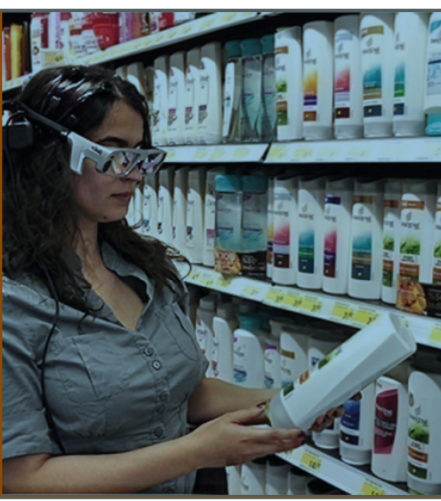Understanding Shopper Happiness
Unilever approached ThinkNeuro with the aim of identifying “happy” and “unhappy” points of the shopping experience and sharing this knowledge with the retailers, so that the implementation of the optimizations would create a happier shopping environment, which, in turn, will increase sales. They were also eager to understand where consumers look, how they feel when they see a certain product, when they are closer to buying, how the shelves should be planned… etc. The best way to answer these questions was to reach unconscious reactions and to conduct ShopperNeuroTM research.
 The aim was to understand shopper “happiness” and “unhappiness” points within the supermarket. Since the buying decision is mostly triggered unconsciously and measuring emotions with claimed data is misleading, shopper dynamics were to be revealed by using consumer neuroscience techniques. ShopperNeuroTM research was, therefore, conducted to understand unconscious shopper reactions within the supermarket. Understanding the most effective shelf plan for different categories, the most efficient layout for shoppers’ decision processes, the effect of POP materials and secondary displays, the relationship between the shopper and the staff… etc. were also part of the research.
The aim was to understand shopper “happiness” and “unhappiness” points within the supermarket. Since the buying decision is mostly triggered unconsciously and measuring emotions with claimed data is misleading, shopper dynamics were to be revealed by using consumer neuroscience techniques. ShopperNeuroTM research was, therefore, conducted to understand unconscious shopper reactions within the supermarket. Understanding the most effective shelf plan for different categories, the most efficient layout for shoppers’ decision processes, the effect of POP materials and secondary displays, the relationship between the shopper and the staff… etc. were also part of the research.
The project took place in five different chain stores (discount, hypermarket, local, national, personal care chains). The research was conducted with 120 volunteers who were aged between 18-50, belonged to A,B,C1, C2 SES groups and 70% were female.
It was critical to conduct the research in real-life conditions since the aim was finding “happiness” and “unhappiness” touch points during the real shopping experience with a holistic approach, taking every detail into consideration, for example other shoppers, smell, impulse buying, feel of the floor tiles… etc. With the help of simultaneous use of EEG and eye tracking during real experience, shopper gaze points and their emotional reactions were revealed. Each increase and decrease in their emotional bond was recorded throughout the experience. In addition, neuroscores based on in-depth interviews were conducted with all participants to show their unconscious reactions during the experience. Therefore, the reasons behind changes in each participant’s emotional bond were explored in one-to-one interviews. With the analysis of each participant’s brain data along with eye tracking, emotional patterns were clustered to create “happiness” points. Common explanations behind these points were thus identified. The action plan was designed for each step in the experience from entrance to exit.
Results
Significant findings affecting shopper experience were revealed with neuro measurements and neuroscore based in-depth interviews. Findings regarding 
The findings were shared with the retailers who had contributed to Unilever’s “win-win” strategy. This study provided support for the retail channel to take actions to increase shopping frequency and number of shoppers by making the shopping experience more joyful and happier. The shared insights led to a more positive relationship with the retailers. In addition, the awareness of neuroscience in the retail industry increased.
In line with the findings of the project, concrete steps were taken in sales channels to increase customer satisfaction and secondary display positioning were reviewed within the framework of the research findings. Unilever made revisions to various items of product packaging. As a result of the findings, alternative stimulus was tested and the most favorable packaging, from a consumer perspective, was adopted.
Unilever reviewed its in-store promotional “push-girls” communication language and style. Also, they revised the in-store visuals based on the research findings in 1370 national and local retail stores which they called “perfect point”. Insights of the study were shared in Unilever’s Global Shopper Network Platform. The results of the project were presented to the company’s customer development team with the participation of different countries, and then rolled out to even more countries.
The Differences in Grocery Shopping Between Men and Women
It was found that, when it comes to grocery shopping, men and women have different motivations aligned with human evolution. As nurturer and gatherers, women tend to look through options and scan the alternatives to find the “best of breed” product for their family. However, as hunters, men tend to “hit and run”. While women value variety, opportunity and “new”; men seek familiar products which aid their fast decision-making.
In addition, creating the perception of variety is very important since the lack of it leads shoppers to feel deceived and trapped.
Shopper experience is the crystallization point of a brand’s communication investments and product performance. Yet, this area remained a black box for a long time since it was not possible to measure shoppers’ unconscious processes - the main driver in the buying decision. Today, with the help of the consumer neuroscience research techniques, it is possible to detect shoppers’ emotional reactions during their real experience and to understand the reasons behind these reactions. This new field that is made possible by neuro research provides many opportunities for retailers and brands to improve in-store experience.